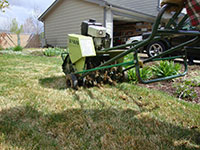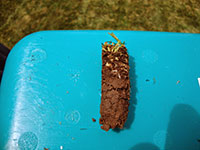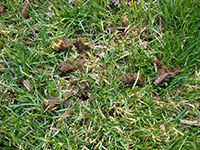Adapted from the CO-Horts blog originally authored by Alison O’Connor, Larimer County Extension

Regular aeration (core cultivation) is one of the best things you can do for your lawn. Aeration allows for better water infiltration to the turf root system, to combat thatch build-up, to allow for better oxygen exchange for roots and to add organic matter to your lawn and soil. And it helps alleviate soil compaction. The general recommendation is to aerate at least once a year. Follow these steps to ensure proper lawn aeration:
- Water your lawn a couple days prior to the aeration event. In order to pull deep plugs, the lawn should have good moisture. If the lawn is too dry, the plugs pulled will be very short or the machine will simply bounce across the surface.
- Before you start aeration, mark your sprinkler heads. It’s very easy to hit a sprinkler head with the machine. The aeration machine generally has one speed–fast–and they aren’t very easy to maneuver.

- The goal of aeration is to “Swiss cheese” the lawn–make as many aeration holes as possible. Up, down, back and forth, horizontally, vertically, diagonally. Try to get the holes on 2″ centers. If the plugs are 2-3″ deep, this is also excellent. This is where commercial aeration may fall short if they only make one pass. One pass tends to result in very few holes several inches apart and does little to improve the health of your turf.
- If you rent equipment, you have the luxury of being able to control how many passes you make. Honestly, you can’t make too many holes—the more holes the better!

- Leave the cores on the lawn once you’re finished. They are full of wonderful organic matter. If you leave the cores, they will break down with a few mowings. If you prefer to rake them up, put them in your compost pile–don’t throw them away.
- Need to seed or fertilize? Do so following aeration. The holes you just created are ideal “germination chambers” for seed. Seed that drops into the holes will stay moist, have good contact with soil and be protected during germination. Fertilizer will also reach turf roots better following aeration (be sure to water it in). On a side note, if you applied crabgrass preventer to your lawn in spring, wait until August to seed–the crabgrass preventer will kill seedling grass.



